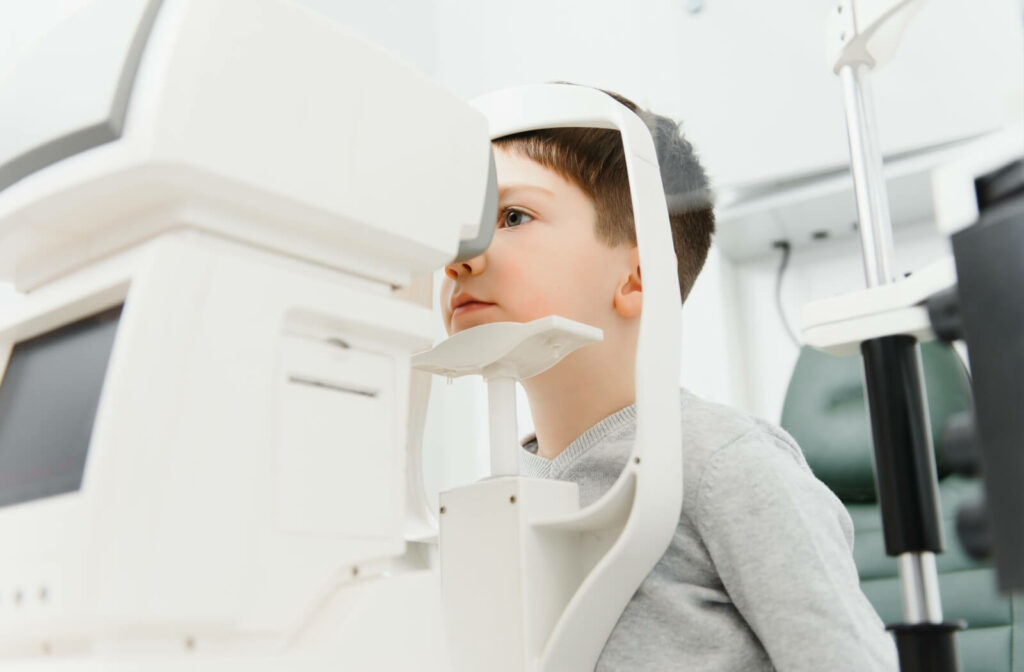Have you noticed your child squinting to see the TV or sitting closer to their tablet than usual? These small habits can sometimes signal a bigger change in their vision—like the early stages of myopia.
While myopia (nearsightedness) can’t be reversed, that doesn’t mean that nothing can be done. The key to myopia control lies in early detection and effective management. Acting early with regular eye exams can help slow the progression of myopia and preserve your child’s vision for the future.
What Is Myopia, Exactly?
Myopia, or nearsightedness, is a common vision condition that makes it hard to see things clearly at a distance. It happens when the eyeball is too long or the cornea is too curved, which causes light to focus in front of the retina (a tissue at the back of the eye that sends light signals to the brain) instead of directly on it.
Myopia usually begins in childhood and tends to progress into early adulthood. The more severe a person’s myopia, the blurrier their distance vision becomes.
Both genetics and lifestyle play a role in how myopia develops. If a parent is nearsighted, their child is more likely to develop the condition . Spending a lot of time on close-up tasks—like reading or screen use—and too little time outdoors may also increase the risk of developing myopia.
Unfortunately, myopia can’t be reversed. The physical changes to a person’s eye—specifically the elongation of the eyeball (called axial length)—are permanent.
How Can You Lower Your Child’s Risk of Myopia?
While it’s not possible to completely eliminate the risk of myopia, that doesn’t mean it’s unavoidable. Small, consistent habits can help reduce the chances of your child developing nearsightedness—or slow its progression.
Here are a few simple, effective tips:
- Encourage daily outdoor time. Kids who spend more time outside tend to have a lower risk of developing myopia.
- Use proper lighting for near work. Whether it’s reading or homework, good lighting helps reduce unnecessary eye strain.
- Support eye health with a balanced diet. Nutrients like vitamin A and omega-3 fatty acids play a role in healthy vision.
Fun fact: many animals have a special layer in their eyes called the tapetum lucidum, which reflects light and makes their night vision about 6–8 times better than ours. While human eyes don’t work the same way, spending more time in natural daylight can help support healthier vision in kids.
One of the most important steps you can take is to schedule regular eye exams for your child. These visits help your optometrist monitor your child’s vision development and catch early signs of myopia. If a problem is detected, you’ll be able to explore treatment options before the condition progresses.
How Is Myopia Treated?
While myopia can’t be reversed, it can absolutely be managed. We can help guide you toward the right solution based on your child’s needs and lifestyle.
Here are some of the most common treatment options:
- Prescription glasses: A classic and reliable solution. Glasses come in a wide range of frame styles and can include lens coatings or tints that enhance comfort and clarity.
- Contact lenses: Contacts offer a broader field of vision than glasses and can be especially helpful for active lifestyles. Daily disposable contacts are a popular choice for their convenience and comfort.
- Laser eye surgery: For adults with a stable prescription, laser surgery is a longer-term option. This procedure reshapes the cornea to help light focus correctly on the retina. It’s not right for everyone, though—your optometrist can determine your eligibility during a laser eye surgery consultation.
- Atropine Therapy: A treatment often used to help slow down the progression of myopia (nearsightedness) in children.
No matter which path you choose, the first step is booking a comprehensive eye exam. That way, we can assess your vision needs and recommend a treatment plan that fits your eyes—and your life.

How Myopia Control Helps Protect Your Child’s Vision
When it comes to myopia, early action matters—and that’s where myopia control comes in. This approach uses a variety of treatments to help slow the progression of nearsightedness as your child grows.
A well-rounded myopia control plan may include:
- Specialized contact lens fittings that are designed to slow the eye’s growth over time
- Training and support to help your child feel confident using and caring for their lenses
- Check-ins every 4 months to monitor how their myopia is progressing
- Contact lens exchanges to adjust for any prescription changes
- Annual retinal imaging to track eye development and guide treatment decisions
These proactive steps help support healthy visual development. The earlier myopia control begins, the more effective it can be in protecting your child’s long-term vision.
Protecting Your Child’s Vision Starts with a Simple Step
Helping your child see clearly today can protect their vision for years to come. While myopia can’t be reversed, early action makes all the difference in how it progresses—and how much it impacts daily life.
At Focus West Optometry, we’re here to help you stay proactive about your child’s eye health. If you’ve noticed changes in your child’s vision, book an eye exam today and let’s take the next step toward protecting their long-term sight.



